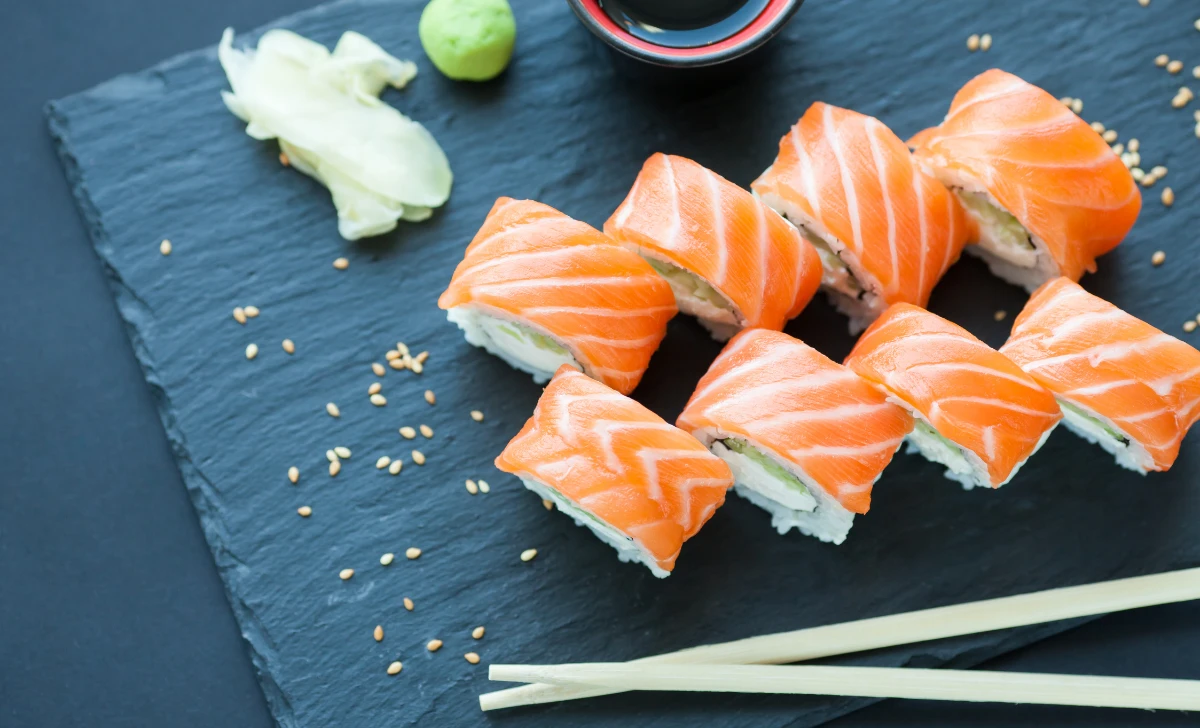Sushi is a popular Japanese delicacy that has captivated taste buds all over the world. This exquisite dish combines simplicity, artistry, and an explosion of flavors. In this article, we will take you on a culinary adventure, exploring the origins, types, and preparation of sushi. Whether you’re a seasoned sushi lover or a curious beginner, this guide will help you master the art of making sushi recipe in your own kitchen.
[ez-toc]
History
The origins of sushi can be traced back to Southeast Asia, where people used to ferment fish with rice to preserve it for long periods. This method allowed the fish to be stored and consumed later, even during times of scarcity. The rice acted as a natural preservative, preventing the fish from spoiling and enhancing its flavor over time. This early form of sushi was called “narezushi” and was likely developed in the Mekong River region.
In the 8th century, narezushi made its way to Japan through trade and cultural exchanges with China. The Japanese embraced this preservation technique and modified it to suit their tastes and available ingredients. They gradually began eating the fish along with the rice, rather than discarding the rice as was done in the original method. This marked the transition from preservation to a delicacy.
Over the centuries, sushi continued to evolve, and different regions of Japan developed their own unique styles and flavors. In the Edo period (17th to 19th centuries), the “Edo-mae” sushi style gained popularity in Tokyo (formerly known as Edo), emphasizing the use of fresh fish caught in Tokyo Bay. It was during this time that sushi chefs began shaping sushi into the familiar oblong shapes we see today.
The true transformation of sushi came in the 19th century with the advent of refrigeration. This technological advancement allowed for the use of fresh fish in sushi preparation instead of relying on fermented fish. As a result, sushi became more widely available and popular among the masses.
In the early 20th century, Hanaya Yohei, a sushi chef in Tokyo, introduced “nigiri sushi” to the world. This style involved placing slices of fresh fish on top of vinegared rice and molding them by hand. Nigiri sushi quickly gained popularity and became a staple in sushi restaurants worldwide.
In the mid-20th century, after World War II, Japan experienced an economic boom, which led to the proliferation of sushi bars and restaurants both domestically and internationally. Sushi’s popularity continued to grow, and it became synonymous with Japanese cuisine around the world.
In recent years, sushi has undergone further innovations and adaptations, incorporating new ingredients, creative presentations, and modern twists. Today, sushi is not just limited to traditional fish and rice combinations but also includes vegetarian options, unique fusion rolls, and diverse toppings.
The rich history of sushi showcases its resilience and adaptability, as it has evolved from a humble preservation method to a global culinary sensation. As sushi continues to enchant palates worldwide, it remains a testament to the artistry and craftsmanship of Japanese cuisine.
Time
| Step | Time (in minutes) |
|---|---|
| Preparing the Rice | 30 |
| Slicing the Fish | 15 |
| Rolling the Sushi | 20 |
| Sushi Serving and Presentation | 10 |
Please note that the times mentioned above are approximate and may vary depending on individual cooking skills and the specific recipe being followed. It’s always a good idea to refer to the recipe instructions for accurate cooking and preparation times.
Ingredients
| Ingredients | Quantity |
|---|---|
| Sushi rice | 1 cup |
| Nori seaweed sheets | 5 sheets |
| Fresh fish (e.g., salmon, tuna) | 8 ounces |
| Cucumber | 1/2 |
| Avocado | 1/2 |
| Soy sauce | 2 tablespoons |
| Wasabi | 1 teaspoon |
| Pickled ginger | For serving |
| Rice vinegar | 2 tablespoons |
| Sugar | 1 tablespoon |
| Salt | 1 teaspoon |
| Sesame seeds (optional, for garnish) | As desired |
Please note that the quantities mentioned above are for a 2-person serving and can be adjusted according to personal preference. Additionally, the choice of fish and additional fillings can vary based on individual preferences and availability.
Directions
1. Preparing the Rice
Ingredients:
- Sushi rice
- Water
Directions:
- Rinse the sushi rice under cold water until the water runs clear to remove excess starch.
- In a saucepan, combine the rinsed rice and water in a 1:1.5 ratio (1 cup of rice to 1.5 cups of water).
- Bring the mixture to a boil, then reduce the heat to low, cover, and simmer for 15-20 minutes until the rice is cooked and the water is absorbed.
- Remove the saucepan from the heat and let the rice sit, covered, for 10 minutes to allow it to steam and become fluffy.
2. Slicing the Fish
Ingredients:
- Fresh fish (e.g., salmon, tuna)
Directions:
- Ensure the fish is fresh and properly cleaned.
- Use a sharp knife to slice the fish into thin, bite-sized pieces. Take care to make clean cuts and maintain consistent thickness.
3. Rolling the Sushi
Ingredients:
- Prepared sushi rice
- Nori seaweed sheets
- Sliced fish
- Cucumber
- Avocado
Directions:
- Place a sheet of nori seaweed on a bamboo sushi mat or a clean, flat surface.
- Moisten your hands with water to prevent the rice from sticking. Take a handful of sushi rice and spread it evenly over the nori, leaving a small border at the top.
- Arrange thin strips of fish, cucumber, and avocado horizontally along the bottom edge of the rice.
- Using the sushi mat, roll the nori tightly from the bottom, applying gentle pressure to keep the ingredients in place.
- Seal the roll by moistening the border of the nori with water.
- Repeat the process with the remaining ingredients to create more sushi rolls.
4. Sushi Serving and Presentation
Ingredients:
- Soy sauce
- Wasabi
- Pickled ginger
- Sesame seeds (optional, for garnish)
Directions:
- Use a sharp knife to slice each sushi roll into bite-sized pieces.
- Arrange the sushi pieces on a serving platter.
- Serve with soy sauce and wasabi for dipping, and pickled ginger for cleansing the palate.
- Optionally, sprinkle sesame seeds on top of the sushi rolls for added flavor and presentation.
Now you’re ready to enjoy your homemade sushi!
Please note that the directions provided are a general guide and can be adjusted based on personal preferences and the specific recipe you are following.
Equipment Required
Nutrition Information
| Nutrition Information | Amount per Serving |
|---|---|
| Serving Size | 4 pieces |
| Calories | 180 |
| Total Fat | 5g |
| – Saturated Fat | 1g |
| – Trans Fat | 0g |
| Cholesterol | 25mg |
| Sodium | 400mg |
| Total Carbohydrate | 26g |
| – Dietary Fiber | 2g |
| – Sugars | 1g |
| Protein | 10g |
| Vitamin D | 1.5mcg |
| Calcium | 20mg |
| Iron | 1mg |
| Potassium | 180mg |
Please note that the nutrition information provided is approximate and can vary based on the specific ingredients and quantities used. It’s always a good practice to calculate the nutrition information based on the exact brands and amounts of ingredients you use in your recipe.
Tips
- Choose high-quality ingredients: Fresh, high-quality ingredients are key to making delicious sushi. Select fresh fish from a reputable source and ensure that your vegetables are crisp and flavorful.
- Use proper sushi rice: Sushi rice is a specific type of short-grain rice that is stickier than regular rice. It’s essential to use the right kind of rice and cook it properly to achieve the desired texture for sushi.
- Season the rice correctly: Season the sushi rice with a mixture of rice vinegar, sugar, and salt while it is still warm. This will give the rice its distinct tangy flavor and help it hold together when making sushi rolls.
- Keep your hands moist: Wet your hands with water before handling the sushi rice to prevent it from sticking to your hands. This will make it easier to shape the rice and work with the other ingredients.
- Slice the fish against the grain: When slicing fish for nigiri or sushi rolls, make sure to cut against the grain to ensure a tender texture and clean presentation.
- Experiment with fillings: While traditional sushi often includes fish, don’t be afraid to experiment with different fillings. Try using cooked shrimp, crab, tofu, or a variety of vegetables to create vegetarian or alternative sushi options.
- Get creative with sushi rolls: Sushi rolls offer endless opportunities for creativity. Add additional ingredients such as cream cheese, tempura, or spicy sauces to create unique flavor combinations.
- Use a sharp knife: A sharp knife is essential for clean and precise cuts when slicing sushi rolls. Sharpen your knife before starting to ensure smooth, professional-looking slices.
- Practice rolling techniques: Rolling sushi takes practice. Start with simple rolls and gradually progress to more complex ones. Be patient and gentle when rolling to avoid squishing the ingredients or tearing the nori.
- Presentation matters: Take the time to present your sushi beautifully. Arrange the sushi rolls neatly on a platter and garnish with pickled ginger and sesame seeds for an attractive and appetizing display.
Pros & Cons
| Pros | Cons |
|---|---|
| ✅ Quick and Easy to Make | ❌ Requires Practice and Skill |
| ✅ Customizable Fillings | ❌ Raw Fish Requires Freshness and Quality |
| ✅ Healthy Ingredients | ❌ Can be Expensive with Premium Ingredients |
| ✅ Versatile and Creative | ❌ Rolling Sushi Requires Specialized Equipment |
| ✅ Impressive Presentation | ❌ Time-Consuming for Larger Quantities |
Conclusion
In conclusion, making sushi at home is not only an exciting culinary adventure but also an opportunity to create personalized, flavorful rolls tailored to your preferences. This timeless Japanese dish offers a harmonious balance of flavors, textures, and presentation that can delight both the eyes and taste buds.
By following the step-by-step instructions provided, you can embark on a sushi-making journey that is both rewarding and satisfying. From preparing the perfect sushi rice to selecting your favorite fillings and rolling them into delectable rolls, the process allows for endless creativity and customization.
Not only does homemade sushi offer a wide range of possibilities for ingredient combinations, but it also allows you to control the quality and freshness of the components. You can explore various fillings, from traditional fish options to vegetarian alternatives, making sushi a versatile option for everyone.
While it may take some practice to master the rolling technique, the effort is well worth it. The sense of accomplishment and the joy of presenting your beautifully crafted sushi creations to friends and family is unparalleled.
So, why not gather the necessary ingredients, embrace your culinary spirit, and embark on an exciting sushi-making adventure? Whether you choose to enjoy it as a special treat for yourself or share it with loved ones, homemade sushi promises a delightful and memorable dining experience.
Get ready to unleash your creativity, indulge in the flavors of Japan, and enjoy the satisfaction of creating your very own delicious sushi. Don’t hesitate to dive in, try new fillings, and make it a truly unique culinary experience that reflects your personal taste.
Remember, the art of sushi-making is not just about the end result; it’s about the journey and the joy of exploring new flavors and techniques. So, roll up your sleeves, embrace the sushi-making adventure, and savor the rewards of your homemade masterpiece. Enjoy!
Facts
- Fact 1: Sushi Origins 🌍
- Did you know that sushi traces its roots back to ancient Southeast Asia? Originally, it was a method of preserving fish by fermenting it with rice. Over time, this preservation technique evolved into the sushi we know and love today.
- Fact 2: Sushi and the Samurai
- ⚔️ Sushi played a significant role in the lives of samurai warriors during medieval Japan. They enjoyed sushi as a portable, ready-to-eat meal that provided sustenance during battles. It was a convenient and nutritious option for their on-the-go lifestyle.
- Fact 3: Sushi Conveyor Belts 🍣🎢
- Conveyor belt sushi, known as “kaiten-zushi” in Japan, is a popular dining concept where plates of sushi travel on a conveyor belt, allowing diners to pick their favorites. This fun and interactive way of enjoying sushi originated in the 1950s and has since spread worldwide.
- Fact 4: Largest Sushi Roll Ever 🏆
- The world record for the longest sushi roll was set in 2006 in Japan. It measured a whopping 2,852 feet (869 meters) in length! Imagine the amount of rice, fish, and seaweed needed to create that gigantic sushi roll.
- Fact 5: Sushi Emoji 🍣📱
- In 2010, the Unicode Consortium introduced the sushi emoji to their character set, allowing people worldwide to express their love for sushi in digital communications. Now, you can easily share your sushi cravings through messages and social media posts.
FAQ’s
Can I use any type of rice to make sushi?
No, it’s best to use sushi rice, a short-grain rice variety, for authentic sushi. Its stickiness and texture are essential for holding the sushi rolls together.
Can I substitute raw fish with cooked fish?
Absolutely! Cooked fish, such as shrimp or smoked salmon, can be used as a delicious alternative to raw fish in sushi rolls.
Is it necessary to use a bamboo sushi mat for rolling sushi?
While a bamboo sushi mat is commonly used for rolling sushi, you can also use a clean kitchen towel or plastic wrap as a makeshift mat if you don’t have one on hand.
How long can sushi be stored before serving?
Sushi is best enjoyed fresh. It is recommended to consume sushi within a few hours of preparation to ensure optimal taste and quality.
Can I make sushi ahead of time for a party or gathering?
Yes, you can prepare sushi rolls in advance and store them tightly wrapped in plastic wrap in the refrigerator for a few hours. However, it’s recommended to add fresh toppings and garnishes just before serving.
Can I freeze sushi rolls for later use?
While it’s possible to freeze sushi rolls, the texture and taste may be compromised upon thawing. It’s generally recommended to consume sushi immediately for the best experience.
How do I prevent the sushi rice from sticking to my hands?
Moisten your hands with water before handling the sushi rice. This will help prevent the rice from sticking and make it easier to work with.
Can I make sushi without using raw fish?
Absolutely! Vegetarian sushi rolls with ingredients like avocado, cucumber, and pickled radish are popular and delicious alternatives to raw fish.
Is sushi a healthy food choice?
Sushi can be a healthy choice as it often includes fresh fish, vegetables, and rice. However, it’s important to be mindful of portion sizes and avoid excessive consumption of sauces and mayonnaise-based fillings.
Can I reuse leftover sushi rice?
It is generally not recommended to reuse leftover sushi rice as it can lose its texture and quality. Freshly prepared sushi rice is best for optimal taste and consistency.












Leave a Review